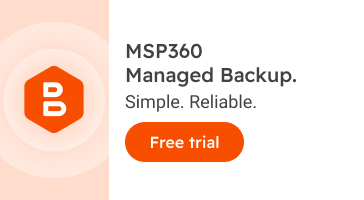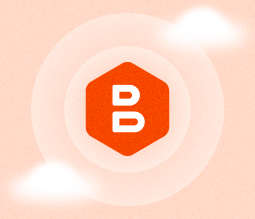Storage
Amazon S3 Storage Classes Explained
Amazon Web Services offers different S3 storage classes for different usage scenarios. This allows reducing storage costs for data that is rarely used and doesn’t require instant access. All Amazon S3 classes have a high level of reliability and support SSL data encryption during transmission, but they differ in their cost.
This article will outline where and which class is recommended for use and explain the difference between Amazon S3 storage classes.
 - everything about backing up to Amazon S3 with MSP360, and more.
- everything about backing up to Amazon S3 with MSP360, and more.
Amazon S3 Standard
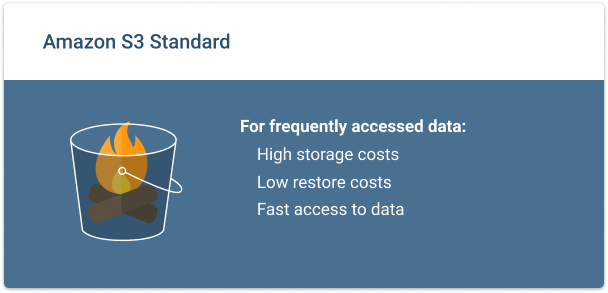
Amazon S3 Standard is designed for high-usage, “hot” data storage and has the following features:
- High capacity and low latency.
- Reliability at 99,999999999% level (of 100 billion objects per year, you are at risk of losing only one of them).
- Availability at 99,99% level (of 10 thousand hours, the data will be unavailable for no more than 1 hour).
- The use of the storage is covered by the Amazon S3 Service Level Agreement, which considers compensation if the level of uninterrupted operation is lower than it was declared.
S3 Standard storage is suitable for the following usage scenarios:
- Website hosting.
- Cloud applications and web services.
- Mobile games and apps.
- Big data.
- Content distribution.
Further reading Amazon Cloud Storage: S3 or Cloud Drive?
Amazon S3 Standard Infrequent Access
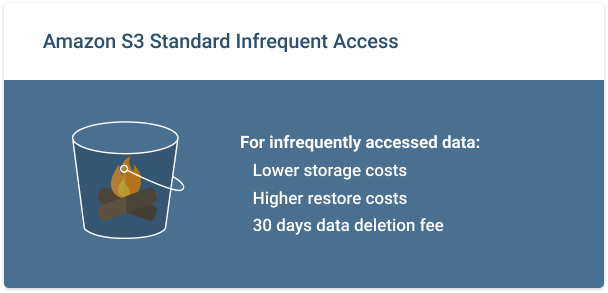
Amazon S3 IA is designed for data that requires less frequent access but longer storage time than S3 Standard.
Low delays combined with high capacity and reliability 99,999999999% ensure the safety of the object for a long period of time. Amazon S3 IA differs from S3 Standard in the following way:
- Availability at 99.9% level within a year (e.g., the probability of request error is a little higher than in standard storage).
- You are charged for data retrieval.
The minimum storage period is 30 days, and the minimum size of the object is 128 KB. S3 IA storage is recommended for long-term storage of files, disaster recovery data, backup, and outdated sync data. As a rule, they require access relatively rarely but must be accessed quickly if necessary. In MSP360 Backup, you can use the S3 Standard IA class as a standard destination for your backups.
Amazon S3 One Zone - Infrequent Access
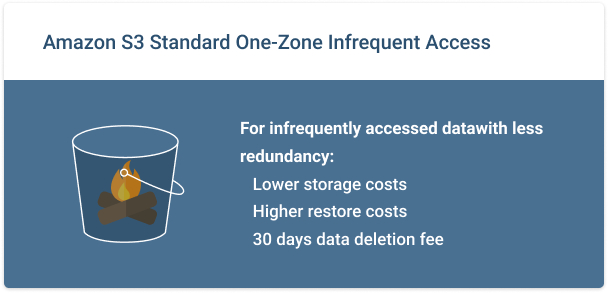
In April 2018, Amazon Web Services has introduced yet another Amazon S3 storage class - Amazon S3 One-Zone Infrequent Access. It is 20% less expensive than Amazon S3 Standard IA due to lesser availability - 99.5% level within a year. It's naming is really all there is to say about that class - instead of three availability zones, Amazon S3 Z-IA stores data in only one.
Amazon S3 Intelligent Tiering
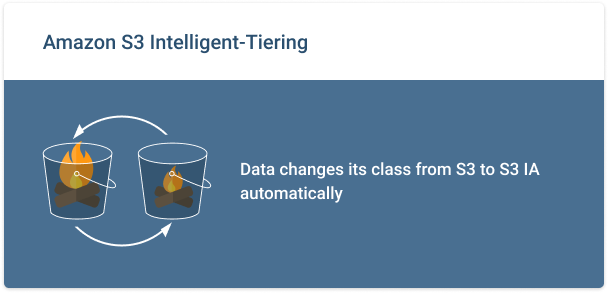
Amazon S3 Intelligent Tiering is and is not a storage class. If you put objects in the S3 Intelligent-Tiering storage class, AWS will monitor and move your data on a per-object level to the proper storage tier. If your object hasn’t been accessed in 30 days, AWS will move it to the infrequent access storage tier. If the object is then accessed after being moved to infrequent access, AWS will move it back to the frequent access storage class for cheaper subsequent accesses.
Thus, Amazon S3 Intelligent Tiering is a storage class that uses other S3 storage classes and moves data automatically between them.
Amazon Glacier Flexible Retrieval

Amazon S3 Glacier Flexible Retrieval is a perfect solution for long storage and data archiving that don’t require instant access. The service allows storing large or small volumes of data at a low cost. At the same time, the retrieval process may take several hours. Amazon Glacier Flexible Retrieval differs from S3 Standard in the following way:
- Extremely low cost.
- Uninterrupted operation is not guaranteed by the Amazon S3 Service Level Agreement.
- The minimum period of storage is 90 days.
There is a charge for data retrieval of more than 10 GB free tier per month. Access to data is limited depending on the chosen retrieval options (expedite retrieval - 1-5 minutes, standard—3-5 hours, bulk - 5-12 hours). The service is optimized for data for which access is rarely required, with an admissible retrieval time of several hours.
A typical example of use is the storage of data archives:
- Media resources archives (news bulletins).
- Archives of organizations working in the health area (patients' information).
- Data obtained during scientific research.
- Backup copies of databases with long storage.
- Replacement of analog media.
You can save objects directly in Amazon S3 Flexible Retrieval or set a Lifecycle Policy on your S3 bucket to automatically archive data.

Amazon Glacier Instant Retrieval

Recently, Amazon introduced the new archive storage class Amazon S3 Glacier Instant Retrieval. This class was designed to provide greater flexibility in storage management and efficiently reduce costs, and it became the most cost-effective and immediately accessible tool for long-term storage.
Now, Amazon offers three archive storage classes for various archival needs:
- Amazon S3 Glacier Instant Retrieval
- Amazon S3 Glacier Flexible Retrieval (formerly S3 Glacier)
- Amazon S3 Glacier Deep Archive
Further reading Amazon S3 Glacier Instant Retrieval Storage Class Is Available in MSP360 Backup 7.2.3 and Explorer 6.2.1
Amazon Glacier Deep Archive
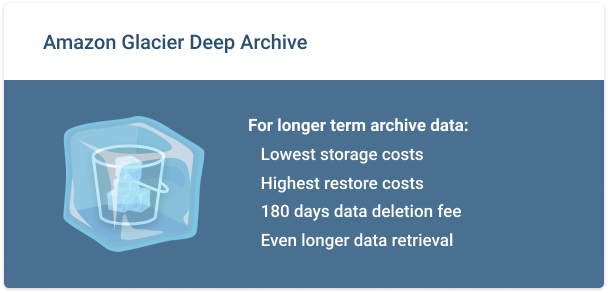
AWS has introduced Amazon Glacier Deep Archive, a further development of Amazon Glacier storage. Once released in 2019, it will be the cheapest storage solution on the market, with a price starting at $0.00099 for storing 1 GB/month.
In Amazon Glacier Deep Archive, you won't have an option for expedited data retrieval—the fastest retrieval time is up to 12 hours. The longest option—bulk retrieval—will take up to 48 hours.
Amazon S3 RRS
Amazon S3 Reduced Redundancy Storage (RRS) allows for reducing storage costs for uncritical data. This can be achieved by reducing redundancy and decreasing the number of replicas. The main difference between RRS and S3 Standard is reliability at 99,99%. This means that, on average, if you store 10,000 objects within a year, you are at risk of losing only one of them.
This solution is perfect for uncritical or easily replicable data of different apps: dynamic websites, business applications, etc. For example, you can use Amazon S3 Standard for keeping images, and S3 RRS — for their previews.
Lifecycle Policy
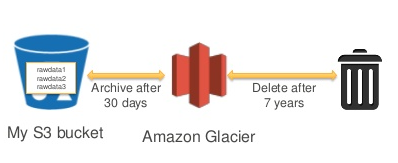
All Amazon S3 storage classes are supported by lifecycle policy. This means that you can optimize the storage costs for objects by setting the rules for their automatic transference to cheaper storage. It is also possible to set up the lifecycle termination policy so that the files are automatically removed after a certain period.
For example, you can save your data in Amazon S3 Standard at a certain time, transfer it to Standard IA storage, and then to Glacier. Later, you can remove it or place it in archive storage.
Amazon S3 Storage Classes Comparison Table
| S3 Standard | S3 RRS | S3 Standard IA | S3 Z-IA | Glacier | Glacier Deep Archive | |
| Redundancy | 99,999999999 % | 99,99 % | 99,999999999 % | 99,999999999 % | 99,999999999 % | 99,999999999 % |
| Availability | 99,99 % | 99,99 % | 99,9 % | 99,5 | N/A | N/A |
| The minimum period of storage | Unlimited | Unlimited | 30 days | 30 days | 90 days | TBA days |
| The minimum size of the object | Unlimited | >Unlimited | 128KB (for less, you are charged as for 128KB) | >128KB (for less, you are charged as for 128KB) | Unlimited | Unlimited |
| Access to the object | Milliseconds | Milliseconds | Milliseconds | Milliseconds | 1 minute - 12 hours, depending on the retrieval options | 12 hours-48 hours, depending on the retrieval options |
| Charge for data retrieval | None | None | Per GB of the data retrieved | Per GB of the data retrieved | 10 GB per month free, then per GB of the data retrieved | TBA |
Backup to Amazon S3 with MSP360
In MSP360, we have developed an endpoint backup solution for managed service providers and standalone users. Both MSP360 Managed Backup and Standalone Backup support backing up to S3.

Backup to Any Amazon S3 Class
Cut costs by backup to the lower-cost Amazon S3 IA and Amazon Glacier storage with MSP360.

Amazon S3 Intelligent Tiering Support
MSP360 Backup 6.0 provides the ability to back up data directly to the Intelligent-Tiering storage class.
Lifecycle and Retention Management
MSP360 Backup fully supports data versioning in Amazon S3. When creating a backup plan, you can create a flexible and automated retention policy.
 AWS IAM Support
AWS IAM Support
MSP360 Standalone Backup securely works with your access and secret keys. Our SaaS solution - MSP360 Managed Backup - works directly with IAM users to ease management and deployment for multiple users and organizations.
Summary
- Do you need an endpoint backup solution for Amazon S3? Check out MSP360 Backup.
- Or MSP360 Managed Backup if you are an MSP.
- If you need to manage objects inside Amazon S3, check out CloudBerry Explorer for S3. It's free and is used with AWS themselves.
